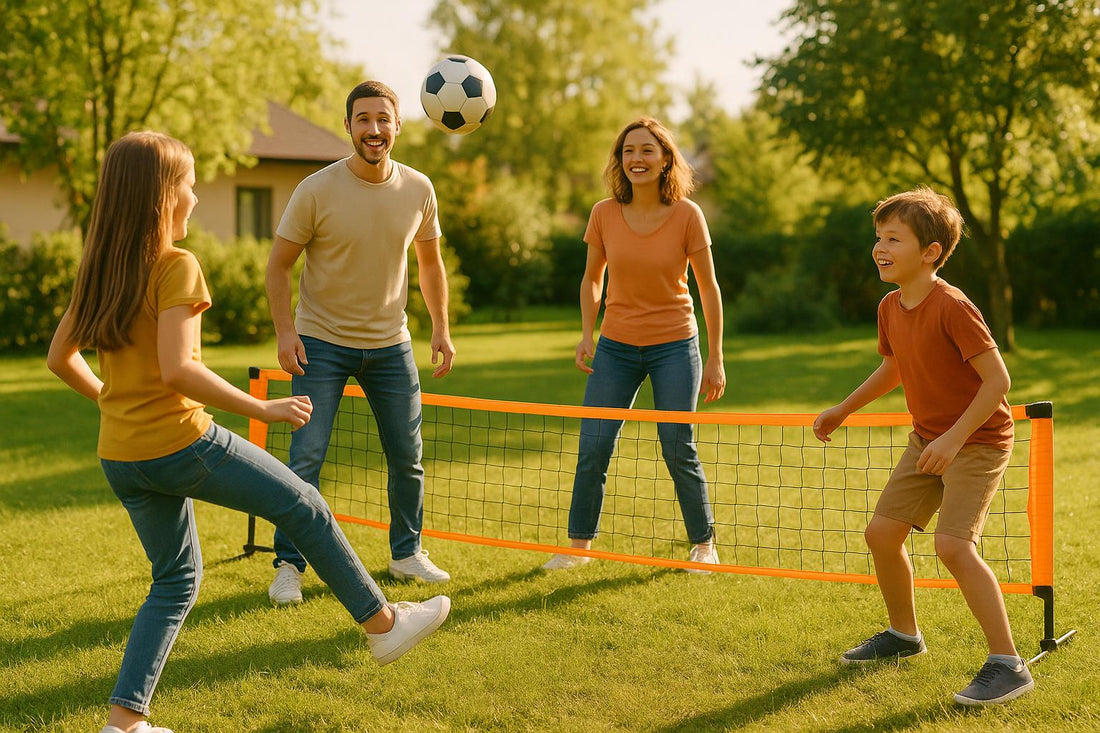
How Soccer Tennis Builds Teamwork at Home
Soccer tennis is a simple, fun game that combines soccer and tennis, making it perfect for families. Players use their feet, chest, and head to volley a soccer ball over a net - no hands allowed. It’s easy to set up in your backyard, driveway, or even at the beach, and it works for all ages. The game promotes teamwork, communication, and bonding, as family members work together during rallies while sharing laughs and encouragement.
Key Highlights:
- Quick Setup: Portable gear allows you to start playing in under a minute.
- All Ages Welcome: A 10-year-old can play as well as a parent or grandparent.
- Teamwork Focus: Families learn coordination, trust, and shared decision-making.
- Improves Communication: Real-time verbal and non-verbal cues sharpen communication skills.
- Flexible Play: Matches can last 10 minutes or hours, fitting any schedule.
Soccer tennis is more than just a game - it’s a way to connect, stay active, and create lasting memories. With options like Kickit Soccer Tennis sets, you can get started easily and enjoy this activity anywhere.
Soccer Tips ~ How to Build Team Chemistry - Online Soccer Academy

How Soccer Tennis Builds Teamwork at Home
Soccer tennis turns your backyard into a stage for teamwork, where family members learn the value of working together. Each rally calls for coordination, trust, and shared decision-making. These lessons on the "field" naturally carry over into stronger, more open relationships at home.
This game creates an atmosphere where cooperation feels effortless. Picture this: one family member starts the play, another sets it up, and a third finishes with a winning shot. This constant back-and-forth teaches everyone to depend on one another and appreciate how every role contributes to the bigger picture.
Working Together Toward Common Goals
In soccer tennis, success hinges on teamwork. Imagine a parent controlling the ball with their chest, a teenager setting up the play, and a younger sibling scoring the point. Every move matters, and every player’s role is essential.
The game also sharpens positioning and communication. For example, a dad might call out, "I've got it!" as he moves to the back corner, giving his daughter time to position herself for the next play. These moments of coordination build trust and show how individual actions weave into team success.
Even strategy becomes a family affair. Together, you might decide whether to aim for quick, aggressive plays or focus on steady, controlled rallies. These discussions teach kids how to share ideas, listen to others, and make decisions as a group. When a plan works, everyone celebrates together. If it doesn’t, the family adapts and tries again, learning to adjust and grow as a team.
Beyond the tactical side, soccer tennis also strengthens bonds through resilience and mutual support.
Building Support and Handling Setbacks
The game naturally creates opportunities for encouragement, especially during challenging moments. If someone misses a shot or makes a mistake, teammates chime in with uplifting words like, "Don’t worry, you’ve got the next one!" or "Nice try - that was close!"
With its quick pace, soccer tennis guarantees plenty of mistakes, offering constant practice in overcoming setbacks. A missed shot doesn’t mean the game is over - another point is always just around the corner. This helps family members develop resilience and learn that mistakes are just temporary hurdles, especially when surrounded by a supportive team.
Problem-solving becomes a shared effort when things don’t go as planned. If a younger child struggles with their touches, others might adjust their play to help out. A parent might set up easier shots, or siblings could switch positions to make the most of each other’s strengths.
The game also teaches families to manage emotions together. Losing a close point might sting, but processing that disappointment as a group helps everyone grow. On the flip side, celebrating a hard-earned victory together reinforces the joy of shared experiences. Whether it’s a win or a loss, these moments create lasting memories and deepen family connections.
How Soccer Tennis Improves Communication Skills
Playing soccer tennis doesn’t just strengthen teamwork - it sharpens communication skills that are essential in everyday life. Just like successful teamwork relies on mutual support, effective communication is the backbone of every great play. Soccer tennis hones both verbal and non-verbal communication, thanks to its fast-paced nature. Players have to signal their moves, call out plays, and respond to teammates - all in real-time. This makes it a fantastic way to practice communication skills that extend far beyond the court.
What starts as a simple game becomes an exercise in speaking under pressure, listening actively, and using body language effectively.
Learning to Listen and Give Clear Directions
Soccer tennis teaches players to communicate with clarity and precision. When someone shouts "Mine!" or "Back corner!" during a rally, there’s no time for vague instructions or misunderstandings. Family members quickly realize that being clear and specific leads to better results.
Parents, for instance, often discover that their usual way of giving instructions doesn’t work in the fast pace of the game. Instead of lengthy explanations, they pick up on the value of short, actionable phrases like "Move left!" These concise directions not only improve gameplay but also carry over into everyday conversations, making communication at home more effective.
Active listening becomes just as important as giving directions. During gameplay, multiple voices might call out instructions or suggestions. Players learn to filter and prioritize these overlapping messages, a skill that proves useful in group projects, family discussions, and other collaborative settings.
Non-verbal communication also takes center stage. A slight nod might signal readiness for a pass, while a raised hand could indicate a shift in position. By paying attention to these subtle cues, family members develop a deeper understanding of each other - something that translates into better communication off the court as well.
Timing is another critical lesson. Players learn when to speak up and when to hold back, as too much chatter can disrupt the flow just as much as silence. This balance helps family members become more thoughtful and intentional in their daily conversations.
Practicing Positive Communication
Soccer tennis also encourages a habit of constructive feedback. When someone struggles with their positioning or touch, the game creates opportunities to offer helpful suggestions in a supportive way. Instead of saying, "You’re doing it wrong", a family member might suggest, "Try using the inside of your foot next time." This approach fosters a positive environment where everyone feels encouraged to improve.
The fast-paced nature of the game also promotes continuous positive reinforcement. With points happening quickly, there’s always another chance to succeed, making it natural to say things like, "Great effort - you’ll get the next one!" Over time, this habit of positivity strengthens family bonds and creates a more supportive atmosphere.
Disagreements are bound to happen - whether it’s about rules, boundaries, or scoring. These moments become opportunities to practice conflict resolution. Families learn to pause, discuss the issue calmly, and reach a fair agreement so they can get back to playing. The shared desire to keep the game going motivates quick and cooperative problem-solving.
Celebrating successes together also plays a big role in improving communication. Whether it’s an incredible rally or a hard-fought comeback, the shared excitement fosters positive interactions. Family members become more comfortable expressing joy and appreciation, which strengthens their connections.
Another valuable lesson is learning to adapt communication styles based on the audience. Parents might use simpler language when coaching a younger child but shift to a more encouraging tone with a teenager. This adaptability makes family members more effective communicators in various situations.
Perhaps most importantly, soccer tennis creates a space where everyone’s voice is valued. Younger kids often surprise their parents with smart strategies, while older family members learn to appreciate different perspectives. This mutual respect strengthens family communication long after the game is over.
sbb-itb-8dc5da3
Tips for Better Teamwork and More Fun
Transforming your family soccer tennis games from a simple pastime into a meaningful bonding experience takes more than just setting up the net. With the right mindset and approach, these games can strengthen family connections and teach teamwork skills that stick with you for life.
Change Team Partners Regularly
Playing with the same teammates every game can get repetitive and even create imbalances. Mixing up the teams keeps things fresh and ensures everyone gets involved. Plus, rotating partners helps family members adapt to different playing styles and encourages better communication.
Switching partners every 10-15 minutes or after each set works well. For a fun twist, write everyone’s name on slips of paper and draw new teams from a hat - this adds an element of surprise and excitement. It’s also a great way for kids to discover new strengths. For example, a shy child might feel more confident when paired with an encouraging parent, while competitive siblings can learn to support each other when they’re on the same side.
Pairing players of different ages often leads to the most rewarding moments. When a parent teams up with a younger child, they naturally adjust their playing style, showing patience and encouragement. Meanwhile, older siblings partnering with younger ones can develop leadership skills and learn to be supportive. These mixed-age teams create opportunities for everyone to shine and build trust.
Make It Fun for Everyone While Adding Challenges
To keep the game engaging for all skill levels, introduce rules and challenges that cater to everyone. Start with simple rules for beginners, like allowing the ball to bounce twice or letting younger kids catch and throw instead of kicking. You can also create "success zones" with cones or chalk, giving less experienced players larger target areas while challenging advanced players with smaller ones.
As players improve, ramp up the difficulty with progressive challenges. For instance, you could require players to use only their non-dominant foot or mandate that the ball must touch both teammates before crossing the net. Time-based challenges are another way to add excitement - set a timer and see how many volleys the family can complete together or aim to score a certain number of points before the clock runs out. These time-based goals often bring out the best teamwork.
For added creativity, try themed games. Play "World Cup Soccer Tennis", where each family member represents a different country, or host a "Skills Challenge Night", awarding points for creativity instead of just winning rallies. These variations make the game inclusive, ensuring even those less focused on competition can contribute and enjoy.
Talk About the Game Afterward
Once the game wraps up, take a few minutes to reflect as a family. These post-game discussions are a great way to reinforce lessons about teamwork and celebrate the fun moments. Keep the conversation positive and focused on growth rather than pointing out mistakes.
Start by having everyone share their favorite moment from the game. This sets a lighthearted tone and helps everyone relive the highlights. Then, discuss what worked well - maybe the team communicated better during a specific set or a certain pairing found a rhythm that led to impressive rallies.
Instead of dwelling on mistakes, shift the focus to "next time" conversations. For example, instead of saying, "You kept hitting the ball too hard", you might ask, "What if we focused on placement instead of power next time?" This approach encourages problem-solving and makes everyone feel like part of the solution.
Kids often have surprisingly sharp insights about teamwork. Give them the space to share their thoughts without cutting in. A simple comment like, "We played better when we cheered each other on", can carry more weight than a long-winded explanation about sportsmanship.
Finally, connect the game to everyday life. If the family worked together to overcome a tough moment, talk about how that same persistence could help with challenges like schoolwork or household chores. If someone showed patience with a struggling teammate, highlight how that quality strengthens relationships beyond the game.
Consider keeping a family journal to jot down funny moments, key lessons, or goals for improvement. Over time, this notebook becomes a treasure trove of memories and a way to see how much everyone has grown - not just as players, but as a team. Looking back on these entries can be a powerful reminder of how far you've come together.
Choosing the Right Soccer Tennis Equipment
Having the right gear can make all the difference when it comes to uninterrupted fun and skill-building during your soccer tennis games. Let’s dive into what to look for and explore some great options.
Key Features to Look For
When picking a soccer tennis set, a few features can ensure you get the most out of your games:
- Portability: A set that packs into a compact carrying case is a must for easy transport, whether you're heading to the park, beach, or a friend's backyard.
- Quick Setup: Look for sets that can be assembled in under 60 seconds. This ensures you can jump into a game without wasting time, whether it’s a quick match before dinner or a weekend activity.
- Surface Compatibility: The best sets work seamlessly on grass, driveways, or sand, so you’re not limited by location or weather conditions.
- Durability: Soccer tennis gear takes a beating, so choosing equipment made from sturdy materials is essential for long-term play.
- Specialized Ball Design: A ball designed specifically for soccer tennis offers a controlled and predictable bounce, making rallies smoother and more enjoyable.
With these features, your games will be reliable and fun, no matter where you play.
Kickit Soccer Tennis Sets and Accessories
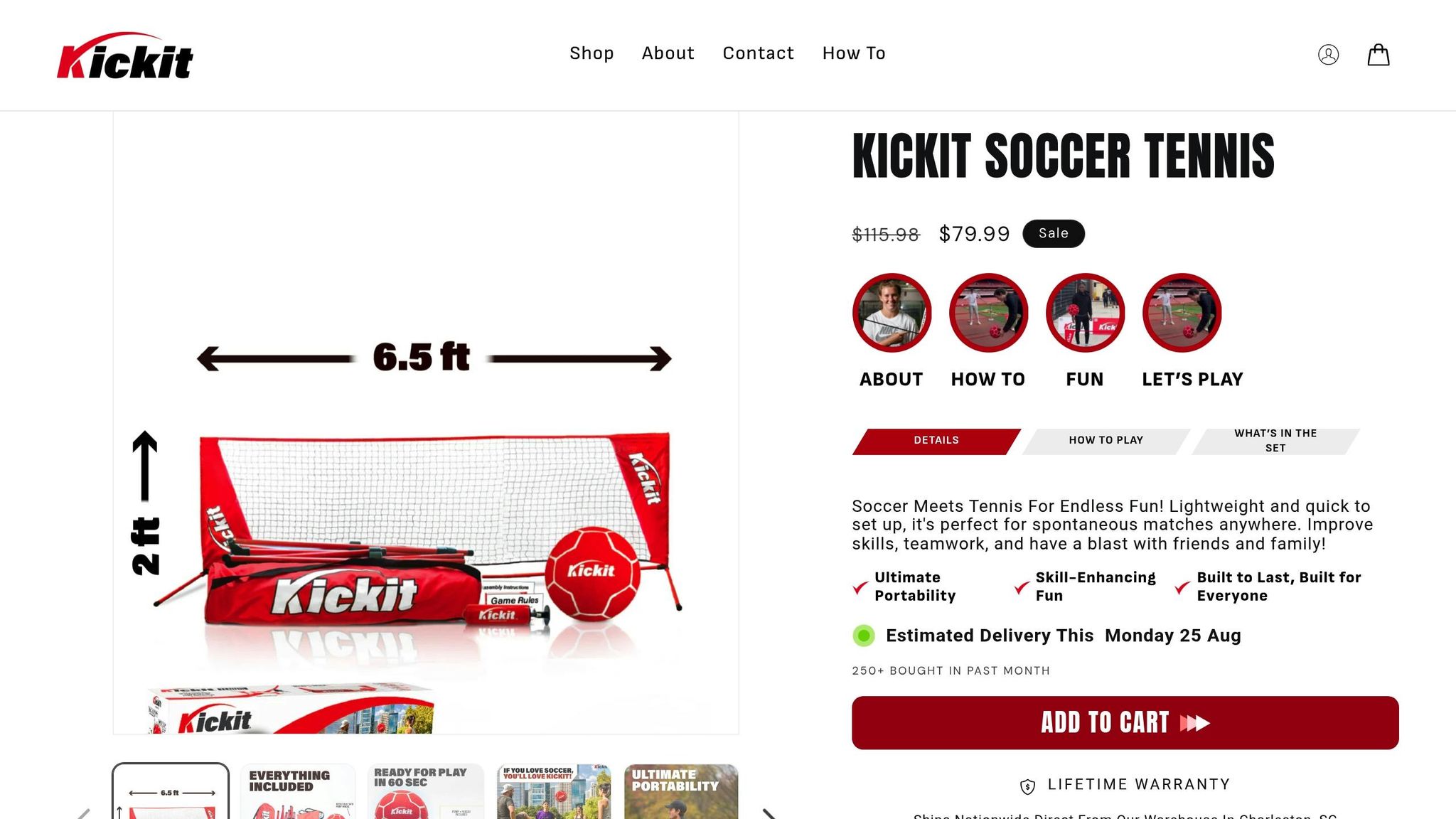
Kickit offers several soccer tennis sets tailored to different needs, ensuring there’s something for every family and skill level. Here’s a closer look:
Kickit Soccer Tennis Set
Priced at $79.99, this is a great starter kit for families or casual players. It comes with everything you need: a portable net, a specially designed soccer tennis ball, a pump, and boundary markers. The entire set fits into a compact carrying case and sets up in under a minute, working well on grass, driveways, or sand.
Kickit Soccer Tennis Pro
For $129.99, this set is ideal for larger families or those who want to play doubles. It includes all the features of the standard set but with a larger net and additional accessories for four-player games. Perfect for competitive matches during family gatherings.
Kickit Inferno Soccer Tennis Set
Also priced at $129.99, the Inferno set is designed for advanced players or families who play frequently. Built with enhanced materials, it’s made to handle tough conditions, like windy days at the beach, ensuring a durable and reliable experience.
| Set | Price | Best For | Key Features |
|---|---|---|---|
| Kickit Soccer Tennis | $79.99 | Beginner families, casual play | Starter set with 60‑second setup for all surfaces |
| Kickit Soccer Tennis Pro | $129.99 | Larger families, doubles play | Expanded net, four‑player design, competitive format |
| Kickit Inferno Soccer Tennis | $129.99 | Advanced players, frequent play | Premium materials, enhanced durability, intensive play |
Each of these sets is designed to perform on multiple surfaces, giving you the flexibility to play at home, at the beach, or anywhere outdoors.
Additional Accessories
- Kickit Soccer Tennis Ball: Available separately for $24.99, this ball is designed to provide the perfect weight and bounce for smooth rallies on any surface. It’s a great replacement or backup option.
- Kickit Trainers: For $39.99, these juggling trainers help players improve ball control and coordination. They’re perfect for solo practice sessions and sharpening skills between family games.
With reliable equipment like this, you can focus on what really matters: having fun, building skills, and creating lasting family memories.
Building Skills and Family Connections with Soccer Tennis
Soccer tennis is a fantastic way to build skills and strengthen family bonds in a way that few activities can match. Playing regularly helps develop communication and teamwork skills that extend far beyond the game itself, enriching everyday interactions. These benefits tie directly into the themes of collaboration and connection we've touched on earlier.
Every rally in soccer tennis requires players to communicate clearly and support one another, reinforcing valuable lessons about working together. The challenges that arise during play also help families build resilience, all while improving physical abilities like coordination and reaction time. Plus, the game's inclusive nature ensures that everyone - regardless of their soccer experience - can join in and learn without feeling pressured.
What sets soccer tennis apart for families is its flexibility and ease of access. Whether it's a quick 15-minute match before dinner or a longer session on the weekend, the game adapts to your schedule. Its portability means you can play anywhere, from your backyard to a vacation spot, making it an ideal choice for families on the go.
To make getting started even easier, Kickit's soccer tennis sets come with everything you need. The standard set, priced at $79.99, is a great option for most families, while the Pro version at $129.99 is perfect for larger groups or more competitive play. Both sets feature a specially designed ball and a quick-setup system, making it simple to fit a game into your routine.
Investing in quality equipment makes a big difference when it comes to keeping the whole family engaged. With a setup that takes less than a minute and gear that works on virtually any surface, families are more likely to play regularly. And it's through that regular play that the real magic happens - skills improve, relationships deepen, and memories are made.
FAQs
How can soccer tennis be adjusted for kids or players with varying skill levels?
Soccer tennis is a game that’s easy to tweak for players of all ages and skill levels. For kids or beginners, swapping in a larger, softer ball can make controlling it much simpler. You can also lower the net to create a more inviting and manageable experience.
If you’re looking to help players improve their skills, try adding fun drills or focusing on techniques like passing and ball control. As players get better, you can gradually raise the difficulty to keep things exciting while fostering teamwork and confidence. These small changes make sure everyone has a chance to enjoy and grow with the game, no matter their experience level.
How can playing soccer tennis at home improve teamwork and communication?
Playing soccer tennis with your family isn’t just a great way to have fun - it’s also an opportunity to sharpen teamwork and communication skills. Start by working with your partner to come up with a basic game plan. This ensures everyone knows their role and can better predict each other’s moves during the match.
Another tip? Develop non-verbal signals, like specific hand gestures or even a quick glance, to stay in sync during those fast-paced moments. And don’t underestimate the power of positive feedback - cheering each other on creates a supportive vibe that keeps everyone motivated. By practicing these approaches regularly, you’ll not only improve your game but also strengthen your bonds beyond the court.
How can playing soccer tennis at home help families build teamwork and problem-solving skills?
Playing soccer tennis at home offers families an enjoyable way to build stronger teamwork and improve communication. The game challenges players to collaborate, anticipate each other’s actions, and align their strategies to keep the ball moving. These shared efforts naturally create a deeper sense of connection and understanding among family members.
Beyond teamwork, soccer tennis sharpens problem-solving skills. Players must think on their feet, adapt to unexpected situations, and tweak their approach as the game unfolds. It’s also a great way to cultivate resilience - learning to bounce back from mistakes and setbacks during play can inspire a mindset of perseverance that carries over into daily life.


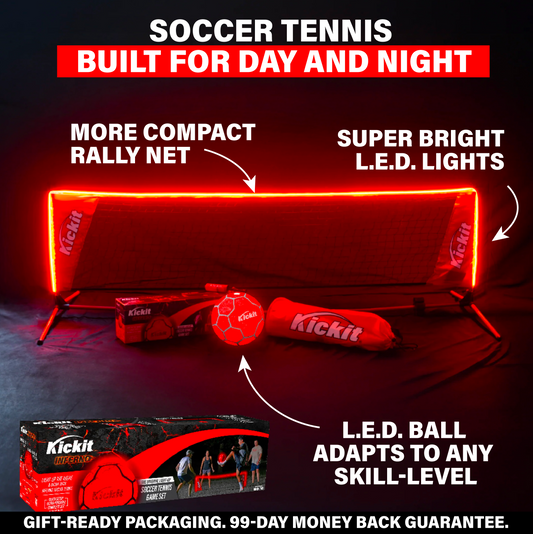
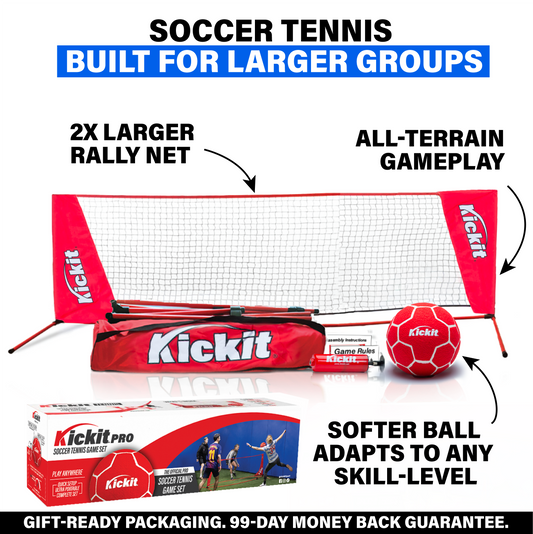
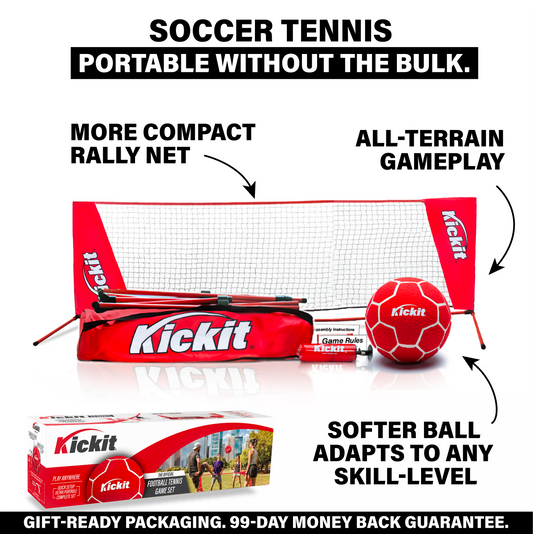
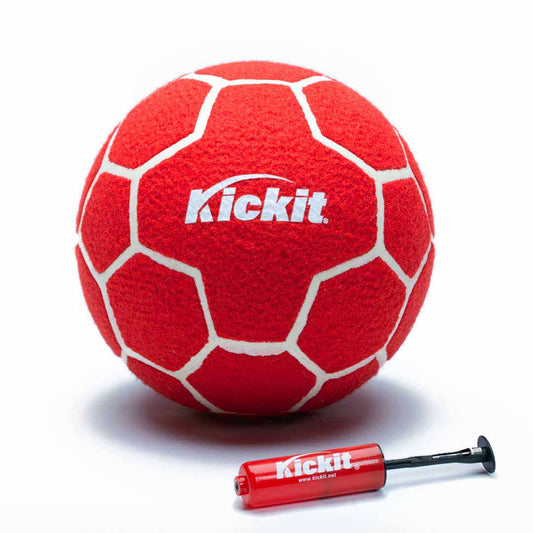
![[NEW] Inferno Kickit](http://kickit.net/cdn/shop/files/LED-Trainer_callouts.png?v=1763481437&width=533)

